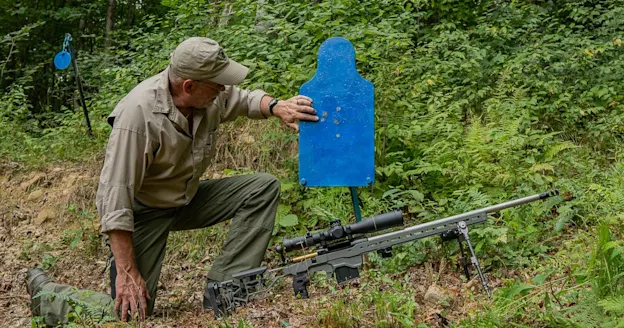_We may earn revenue from the products available on this page and participate in affiliate programs. Learn more ›
_
The Long Game is a new series designed to improve your long-range-shooting skills. This story is the ninth installment.
If you do not have a good rifle zero at 100 yards, it will be impossible to get good hits at 1,000 yards. Your zero is critical because a zero that is off by two-tenths of an inch at 100 yards, will be off two inches at 1,000 yards. These two inches will be even larger when you start applying your firing solution, because it is impossible to calculate the perfect firing solution. Small errors in distance, wind, and atmospheric conditions will occur. In addition to that, there are the actual shooting mistakes you will make as you press the trigger. You must begin with a good zero. Here’s how it’s done:
Level the Reticle
First we want to make sure the reticle in your rifle scope is level. This is important because if it is not, as you dial in corrections to hit at distance, the reticle will not be moving in a perfect vertical direction. At distance, your bullets will strike to the left or right of your aiming point. To check to see if your reticle is level, once you have selected the load you want to use, fire a 3-shot group at 100 yards and then dial up 20 MOA or 4 MILs of vertical correction, and fire another three-shot group. If your reticle is level, the second three-shot group will be directly above the first three shot group. (You can use a level and draw a line on your target to determine this.) Otherwise, it will be to one side or the other. If so, you’ll have to very slightly rotate the scope in the rings to find true level.
Getting a Precise Rifle Zero
Now you need to transition from a rough zero to a perfect rifle zero at exactly 100 yards. (If your zero is established at 99 yards, it will correlate to 10 yards off at 1,000.) To do this, fire a 5-shot group and physically measure—do not look through the rifle or spotting scope and guess—the horizontal and vertical distance from the center of that group to the actual point of aim. Then, make the necessary adjustments to the windage and elevation dials of your rifle scope, let the barrel fully cool, and fire another 5-shot group. Chances are you will be very close, but not exact, so once again physically measure from the center of the 5-shot group, and repeat.
200-Yard Confirmation
Once you have what you feel is the perfect rifle zero from the prone position
at 100 yards, it’s a good idea to conduct the exercise again at 200 yards. However, at 200 yards do not concern yourself with the vertical distance the center of the group is from the point of aim. You’ll correct this with a shooting solution later. What you’re interested in here is in how far the center of the group is horizontally from your point of aim. It can be hard to see minute errors in zero at 100 yards when you are dealing with a 5-shot group measuring, say, .75 inch. At 200 yards, you may need to make a one or two click windage adjustment to further refine your 100-yard zero.
Setting Scope Turrets
Finally, confirm rifle zero again with at least one more 5-shot group at 100 yards. Make any final adjustments, and then most importantly, set your windage and elevation turrets to zero. This is critical because all your subsequent firing solutions for distance will begin at this zero setting. Once you’ve done this, record the information in your logbook. Remember the log/data book we’ve been talking about in previous sections? That logbook is essentially the biography of your rifle. In it you should list all your firing solutions, conditions, and results. This is called DOPE (data of previous engagement) and it will be invaluable as you begin stretching the distance to 500 yards and beyond.
To this point you are probably beginning to see the complexity of long-range shooting. However, you have not seen anything yet. Wind, which we will discuss in the next part, is the biggest X-factor.
Previous Installments in The Long Game
Part 2: Why You Need a Ballistics Calculator for Long Range Shooting
Part 5: How to Select the Best Rifle Scope for Long Range Shooting
Part 6: What to Look for in Rifle Bipods and Other Shooting Accessories
Part 7: Tips on Finding the Best Ammo for Long Range Shooting
Part 8: How to Master the Prone Position






